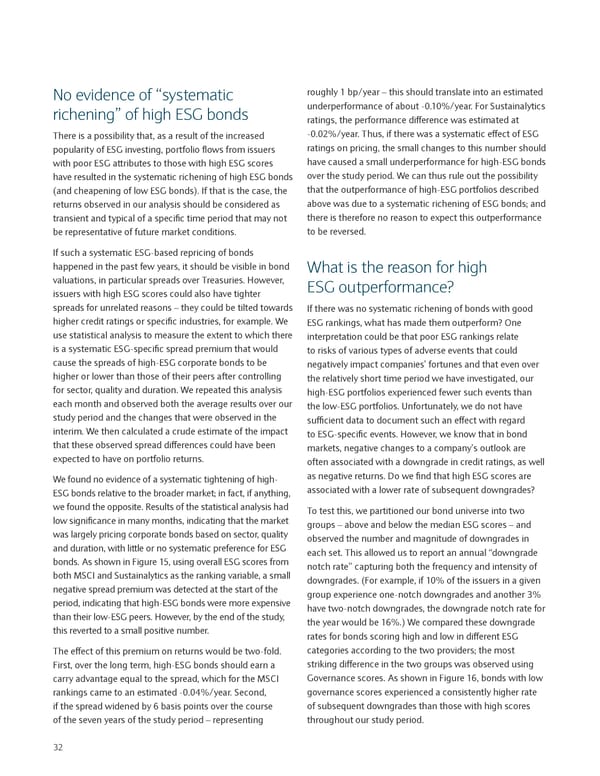No evidence of “systematic roughly 1 bp/year – this should translate into an estimated richening” of high ESG bonds underperformance of about -0.10%/year. For Sustainalytics ratings, the performance difference was estimated at There is a possibility that, as a result of the increased -0.02%/year. Thus, if there was a systematic effect of ESG popularity of ESG investing, portfolio flows from issuers ratings on pricing, the small changes to this number should with poor ESG attributes to those with high ESG scores have caused a small underperformance for high-ESG bonds have resulted in the systematic richening of high ESG bonds over the study period. We can thus rule out the possibility (and cheapening of low ESG bonds). If that is the case, the that the outperformance of high-ESG portfolios described returns observed in our analysis should be considered as above was due to a systematic richening of ESG bonds; and transient and typical of a specific time period that may not there is therefore no reason to expect this outperformance be representative of future market conditions. to be reversed. If such a systematic ESG-based repricing of bonds happened in the past few years, it should be visible in bond What is the reason for high valuations, in particular spreads over Treasuries. However, ESG outperformance? issuers with high ESG scores could also have tighter spreads for unrelated reasons – they could be tilted towards If there was no systematic richening of bonds with good higher credit ratings or specific industries, for example. We ESG rankings, what has made them outperform? One use statistical analysis to measure the extent to which there interpretation could be that poor ESG rankings relate is a systematic ESG-specific spread premium that would to risks of various types of adverse events that could cause the spreads of high-ESG corporate bonds to be negatively impact companies’ fortunes and that even over higher or lower than those of their peers after controlling the relatively short time period we have investigated, our for sector, quality and duration. We repeated this analysis high-ESG portfolios experienced fewer such events than each month and observed both the average results over our the low-ESG portfolios. Unfortunately, we do not have study period and the changes that were observed in the sufficient data to document such an effect with regard interim. We then calculated a crude estimate of the impact to ESG-specific events. However, we know that in bond that these observed spread differences could have been markets, negative changes to a company’s outlook are expected to have on portfolio returns. often associated with a downgrade in credit ratings, as well We found no evidence of a systematic tightening of high- as negative returns. Do we find that high ESG scores are ESG bonds relative to the broader market; in fact, if anything, associated with a lower rate of subsequent downgrades? we found the opposite. Results of the statistical analysis had To test this, we partitioned our bond universe into two low significance in many months, indicating that the market groups – above and below the median ESG scores – and was largely pricing corporate bonds based on sector, quality observed the number and magnitude of downgrades in and duration, with little or no systematic preference for ESG each set. This allowed us to report an annual “downgrade bonds. As shown in Figure 15, using overall ESG scores from notch rate” capturing both the frequency and intensity of both MSCI and Sustainalytics as the ranking variable, a small downgrades. (For example, if 10% of the issuers in a given negative spread premium was detected at the start of the group experience one-notch downgrades and another 3% period, indicating that high-ESG bonds were more expensive have two-notch downgrades, the downgrade notch rate for than their low-ESG peers. However, by the end of the study, the year would be 16%.) We compared these downgrade this reverted to a small positive number. rates for bonds scoring high and low in different ESG The effect of this premium on returns would be two-fold. categories according to the two providers; the most First, over the long term, high-ESG bonds should earn a striking difference in the two groups was observed using carry advantage equal to the spread, which for the MSCI Governance scores. As shown in Figure 16, bonds with low rankings came to an estimated -0.04%/year. Second, governance scores experienced a consistently higher rate if the spread widened by 6 basis points over the course of subsequent downgrades than those with high scores of the seven years of the study period – representing throughout our study period. 32
 Sustainable Investing and Bond Returns Page 35 Page 37
Sustainable Investing and Bond Returns Page 35 Page 37